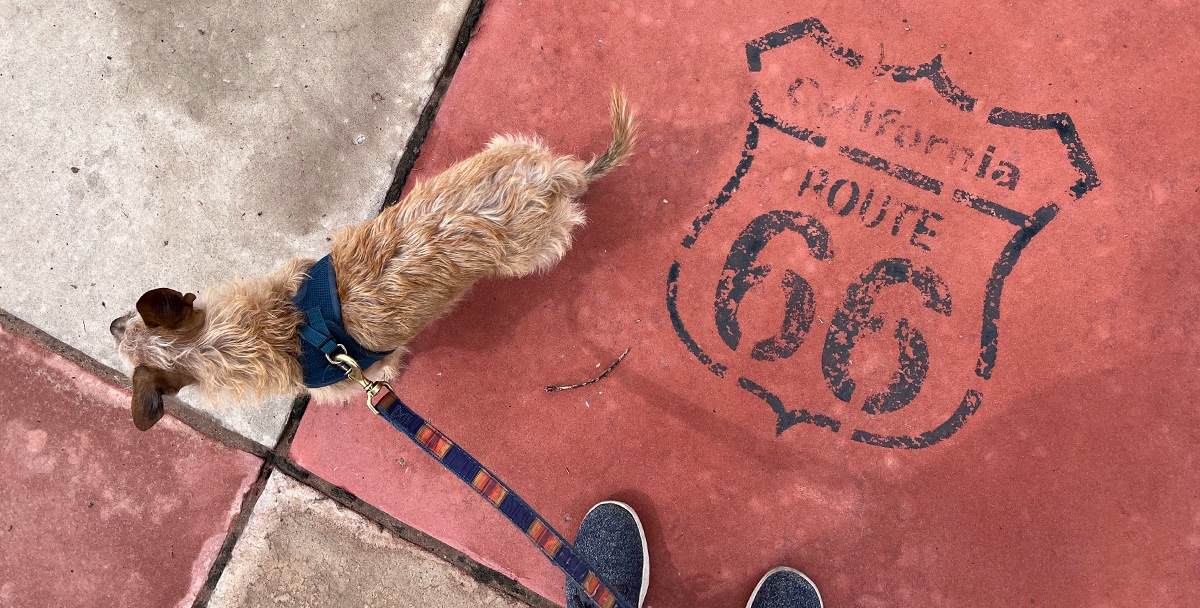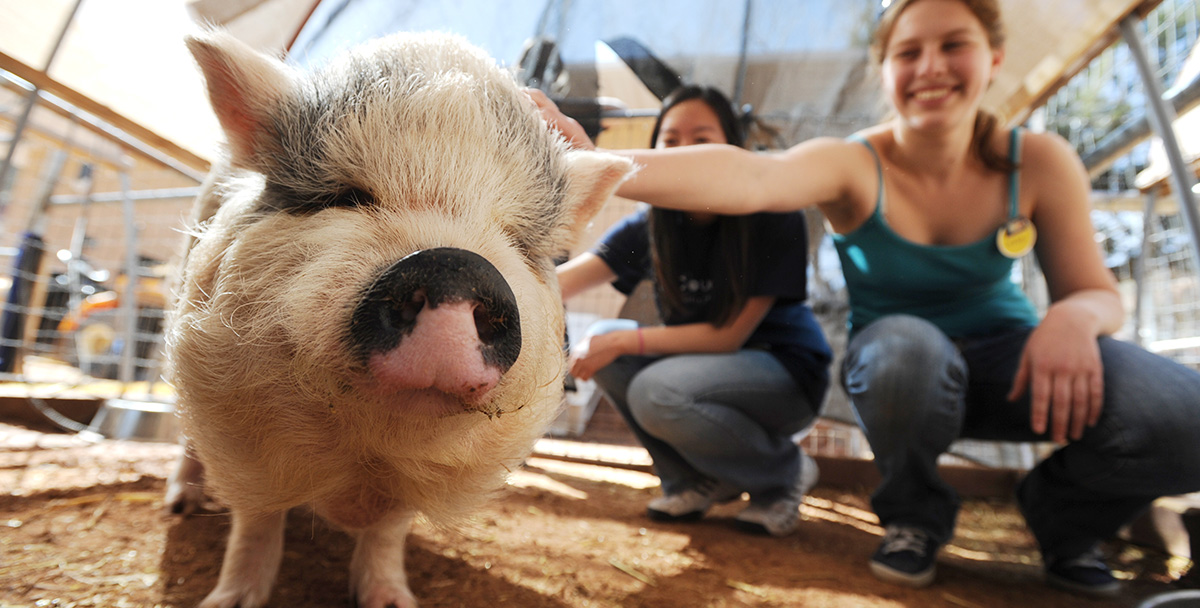After 30 years of living through Pennsylvania winters, I was ready for a change. With the goal of trading my mittens for flip-flops, I began to plan a move to Los Angeles. There was a lot to consider, including the travel itself: Moving across the country would mean an over 2,500-mile drive with my two cats.
George and Miku had no idea what they were in for, and neither did I. I expected that the drive would be a learning experience, but I was not ready for trial by fire. I ran out of canned food. Miku squeezed halfway out of her poorly latched cage. We arrived at our new home intact but frazzled.
Cats are resilient creatures; George and Miku were the embodiment of the word “trust.” They forgave me for feeding them emergency truck-stop kibble, but my lack of planning made the trip more difficult for everyone involved.
When family responsibilities called me back East earlier this year, I vowed to do better by my new friend, a 14-month-old kitten named Thursday.
With the right preparation, a long-distance drive with a reticent cat doesn’t have to be a slog. Follow this guidance from fellow feline owners and vets to make your trip manageable – and maybe even fun.
Practice “Car Training”
To help your cat adjust to the vehicle in small doses before a long trip, drive your cat around the neighborhood or just sit together in your parked car. “Without even leaving the driveway, they get to explore the car, smell it, examine it top to bottom so it’s not this completely alien environment,” says Dr. Aziza Glass, owner of Personal Touch Veterinary Clinic in Houston, Texas.
You can also give your cat treats while they’re exploring, Glass says, so they’ll associate the car with rewards.
When Kelton Wright, a writer in Colorado, was moving cross-country, she knew her cat, Finn, would not take well to the 17-hour drive. “As soon as you get on a highway, he just loses his mind,” she says. She and her husband began car training, putting Finn in their Forester for 15-minute drives, usually to their friends’ house. “They were our cat sitters, and Finn loves them,” she says.
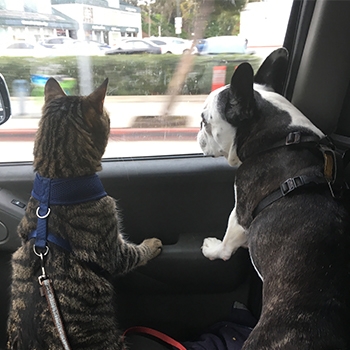

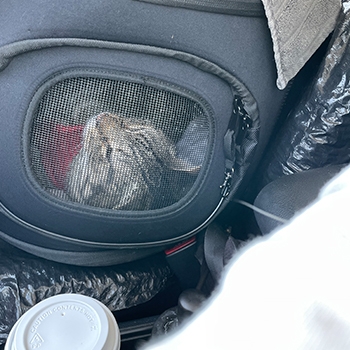
They also acclimated Finn to his travel carrier by leaving it open in the bathroom for months, lined with his favorite blanket “so he’d think of it as a cat bed,” Wright says. “And we filled it with catnip. This was a real long con.”
If you’re even thinking you might travel with your cat at some point, Wright recommends training them to accept wearing a leash and harness, a process that can take months. This preparation makes pit stops easier on the road.
Wright trained Finn as a kitten by having him wear the leash and harness around the house until he was comfortable with it. “He doesn’t go for walks, but he goes in the yard with us,” she says. On the trip, she pulled the Forester over on quiet roads to put a disposable litter box outside. “I’d take him out on his harness, and he’d use it,” she says. “He’s such a good boy.”
Prep for Emergencies
Take the time to get your cat’s medical records in order. For Thursday, my new kitten, that meant locating the digital copies of his adoption records that showed his immunizations were current. If your cat has been in the family longer, call your vet and get copies of your appointment history. This will all help if you have any reason to see a vet on the road.
It’s not only immunization history that’s important, says Glass. A cat’s medical records will show blood test results and other health information that can help a vet know what to look for and even rule out certain diseases, she says.
Plus, some states require proof of rabies vaccinations, and a vet may not be able to see your cat without it. One way to take care of this requirement is to request and carry paper copies, but it’s even easier to ask your vet to email a PDF and “have it in the cloud,” Glass says.
You can save digital paperwork on an app such as Xodo PDF reader, which is free and compatible with Apple and Android phones.
If you know where you’ll be stopping each night, it doesn’t hurt “to plan ahead and know where the closest emergency vet is,” says Dr. Abigail Pines, a veterinarian at Animal General, a pet clinic in New York City. But don’t stress if you’re not able to research in advance. If you search for “emergency vet” on your phone’s map app, that should bring up your closest options.
Before you leave, “you can always ask your primary care vet if they have any referrals,” Glass says. “It’s very possible that your clinic you’re seeing in Texas has sister locations in the state or city that your destination is.”
Ask About Medication
If your cat regularly takes medication, make sure you have enough to last your entire trip plus a few extra days, just in case. If you feel your cat may need medication to handle travel stress, talk to your vet about your concerns.
When Pines was in veterinary school in Ithaca, New York, she often made the five-hour drive back to New York City in her 2011 Impreza with her cat, Amelia, in tow. “I did not have to medicate her, but I do frequently have owners ask about long travel for the car,” she says.
“If it’s a really long drive – people are moving across the country – I’ll prescribe a sedative to keep their cat calm. I always say they may not need it, but at least you have it on board and won’t be super stressed about the drive.”
Wright gave Finn a prescribed sedative called gabapentin, which comes in tablet and liquid form, but cautions that it may upset your cat’s stomach. She woke up at 3 a.m. to administer it two hours before they hit the road: “We gave him time to have his stomach issues at home.” Again, talk to your vet about what makes sense for your cat.
Dogs are more prone to car sickness than cats, says Glass, but cats aren’t immune. Do a test drive to see how your cat reacts to the motion of the car, she recommends. If your cat does suffer from car sickness, she would prescribe Cerenia®, a small tablet.
Choose a Carrier
Brooke Steever’s 13-year-old cat, Cosmo, goes on several road trips a year. Steever, a pastry chef who works seasonally, drives her Impreza up and down the East Coast for jobs, usually a four- to six-month contract, before she’s on the road again.
“Our trips are usually between Florida to New Jersey and then New Jersey to somewhere in New England, but he has been all the way to Seattle,” she says.
For Steever, finding the right carrier was key. She likes a duffel bag carrier that can be buckled into her vehicle’s seat belt and allows Cosmo to stick out his head.
Place your carrier in the back seat, says Glass. “If the cat is in the front seat, they could be injured from the airbag if it is deployed.” Also, she adds, look for a carrier that has enough space so your cat can move around, with space for food and water as well.
Wright recently got a foldable carrier by FRiEQ® that she loves. Another good option is the Subaru Pet Carrier and Mobile Pet Bed for cats or small dogs, which has been crash-tested and is certified by the Center for Pet Safety.
Pack a Cat Kit
I made sure to bring along some kitty comforts from home, including a beloved bed and a few favorite toys. More than once, I pulled a catnip mouse out of my purse when reaching for my wallet.
Steever’s must-pack items include a lidded container that she uses for a litter box, a mini dustpan and broom to clean up any food or litter off the floor of hotel rooms, and a zip-close bag of Cosmo’s favorite treats. “And if it’s really hot, I will pack ice packs for him to lie on to cool him down,” she says. “Sometimes with the sun, the air conditioner isn’t enough.”
“I brought old towels, paper towels and cleaning spray in case he had an accident in the carrier,” Wright says of her 17-hour drive with Finn.

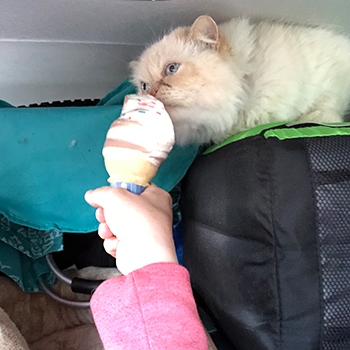
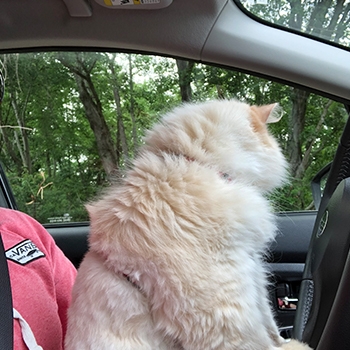

For food, pack more than you expect to need. If you normally feed a portion of a can at mealtime, you may want to switch to smaller cans so you don’t waste food. It can be difficult to keep partially used cans fresh and prevent bacterial growth while on the go.
Steever, who uses kibble, recommends preportioning meals in individual bags. “I portion Cosmo’s meals for the number of days on the road so I don’t have to lug a big bag of cat food in,” she says. Try a reusable silicone bag, such as a Stasher®, to avoid creating waste.
Plan for Breaks and Hotels
On my cross-country adventure, I stopped roughly every two hours, long enough to check on my companions and offer fresh food and water.
“One of the main things I’ve learned is to track out how far you want to go each day and get your hotel room in advance,” Steever says. “There’s been so many times I’ve been stuck without a pet-friendly motel and had to drive farther than I wanted. La Quinta® is pet friendly. I often look for that as my stopping point.”
For me, the BringFido app was an indispensable resource for locating hotels that permit cats while also providing information on amenities for humans. Booking a hotel with interior hallways means there’s little chance your furry charge will slip out while you visit the ice machine.
Check for open windows or anything that invites mischief, such as dangling wires, before opening the carrier. Take special care to notice nooks and crannies your cat might sneak into, like behind furniture or under the bed. Set out fresh food and water and prepare the litter box immediately so your cat knows he can settle down.
And remember: Your cat will adapt. “The first time we traveled, Cosmo would always try to hide under a blanket,” Steever says. “Now he’s so used to it that he stands up and looks out the window.”
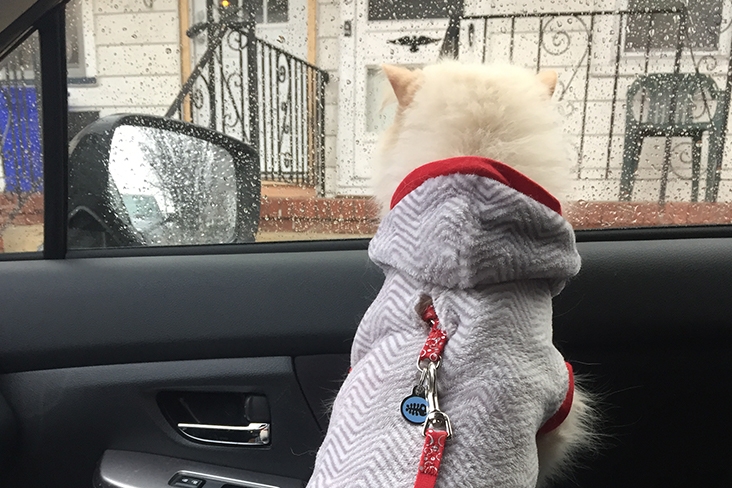
Additional reporting by Claire Zulkey
- Acclimate your cat to the car with short, treat-laden rides
- Select a cat carrier, and let your cat become familiar with it
- Plan your route with reservations at cat-friendly hotels
- Get a copy of your cat’s medical records from your veterinarian
- Consult your vet about medication if your cat gets carsick or nervous
Packing List
- Cat bed
- Favorite toys
- Portable litter box (can use a lidded plastic container)
- Cat litter
- Mini dustpan and broom
- Old towels/rags
- Paper towels
- Pet-friendly cleaning spray
- Cat treats
- Food (either small cans or kibble portioned in bags by day)
- Medications (regular or prescribed for the trip) with extra doses
- Travel bowls for food and water
- Cat carrier
- Cat harness and leash
On the Road
- Make frequent stops to check on your cat and let them walk outside
- Be sure your cat has access to clean water and food while in the car
- Check your hotel room for hazards (loose wires, spots your cat could hide) before letting them out of the carrier
Download and print the Cat Road Trip Checklist.



